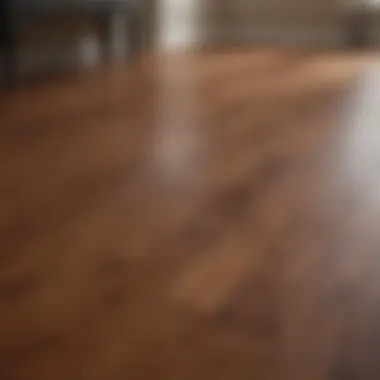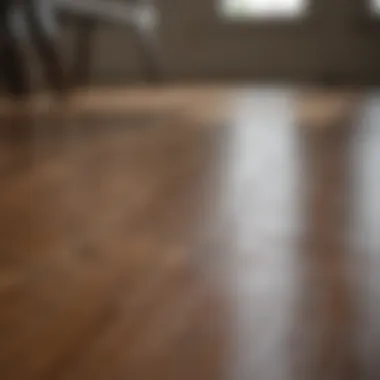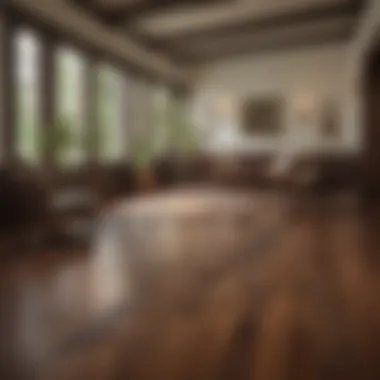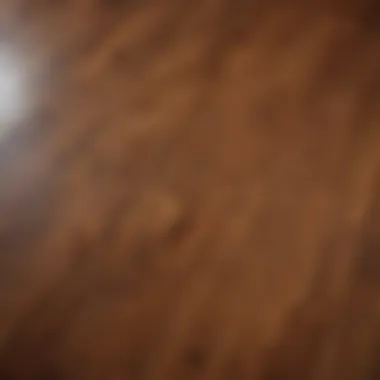Refinished Hardwood Floors: A Comprehensive Exploration


Intro
Hardwood floors can define the character and comfort of a home. Over time, even the most stunning hardwood surfaces may lose their luster. This is where the art of refinishing comes into play. Understanding the intricacies of this process not only enhances one's home aesthetic but also extends the longevity of the flooring. This article explores how refinishing hardwood floors can transform a space and offers a detailed guide on how to achieve impressive results.
Design Inspiration
Trending Styles
When considering refinishing, it is essential to look at current design trends. Popular styles now lean towards a more natural finish that highlights the grain of the wood.
Wide plank flooring is often considered in modern spaces, offering a rustic yet sophisticated feel. Alternatively, herringbone patterns have emerged as a stylish choice, creating visual interest in open areas. Homeowners can also think about distressed finishes, giving floors a vintage character that pairs well with various decor styles, from farmhouse to contemporary.
Color Palettes
Color choice can significantly influence the mood of a room. The classic natural wood tone remains popular, but many are now leaning towards deeper shades such as walnut or espresso. These colors add warmth and richness to the decor.
Soft whites or grays can also be used, which offer a modern and airy feel. For a bolder statement, consider colors like navy blue or deep green, which can introduce a striking contrast against light-colored furnishings.
"The choice of color not only defines the floor but intertwines with the overall design narrative of the space."
Practical Tips
Maintenance & Care
Once the refinishing is complete, upkeep becomes crucial. Regular cleaning prevents dirt and debris from scratching the surface. A microfiber mop is ideal for this task. Additionally, applying a protective sealant can prolong the finish's life, requiring reapplication every few years to maintain durability.
Budgeting & Planning
Refinishing can be a cost-effective way to improve home aesthetics, but budgeting is crucial. Costs can vary widely based on several factors:
- Type of wood
- Size of the area to be refinished
- Techniques used for refinishing
It's advisable to get multiple quotes from professionals to determine the best route. If attempting a DIY approach, ensure you have the proper tools and knowledge, as mistakes can lead to costly fixes.
Investing time in researching techniques and options can yield a beautiful outcome that elevates the entire home.
Understanding Hardwood Floors
Understanding hardwood floors is essential for both homeowners and design enthusiasts. These floors are not just functional elements of a home; they play a significant role in the overall aesthetic and ambience of a space. This section aims to clarify various aspects of hardwood floors, guiding readers through their importance and the nuances involved in refinishing.
The Significance of Hardwood in Interior Design
Hardwood floors carry a unique significance in interior design. They provide a warm, rich appearance that enhances any room's character. The natural grains and textures found in hardwood add depth and sophistication to a space. Also, hardwood is versatile, complementing various styles ranging from modern to traditional. Choosing hardwood floors can increase a home's appeal and value, making them a wise investment for many homeowners. In times of resale, homes featuring hardwood are often more attractive to potential buyers.
Types of Hardwood Floors Available
When selecting hardwood floors, understanding the types available is crucial. Two primary categories dominate the market: solid hardwood and engineered hardwood.
Solid Hardwood
Solid hardwood floors are made from a single piece of wood. Their key characteristic lies in their durability and ability to be sanded and refinished multiple times. This feature extends their lifespan significantly, making them a popular choice. However, solid hardwood is susceptible to changes in moisture. In humid or damp climates, they may warp or swell. Therefore, proper maintenance and careful selection of the installation environment are essential considerations.
Engineered Hardwood
Engineered hardwood consists of multiple layers, with a top layer of solid wood and layers of plywood underneath. Its key characteristic is stability, making it less prone to warping. This type is beneficial for various climates, including areas with fluctuating humidity. The unique feature of engineered hardwood lies in its ability to mimic the appearance of solid hardwood while being easier to install. However, its lifespan is shorter compared to solid hardwood, as it can only be refinished a limited number of times.
Indicators for Refinishing
Recognizing when your hardwood floors need refinishing is vital for maintaining their beauty and functionality. Several indicators can signal the need for this process.


Scratches and Dents
The presence of scratches and dents often indicates wear and tear. These marks not only detract from the aesthetic appeal; they can also trap dirt and grime. Addressing scratches promptly can help preserve the flooring. Ignoring them might lead to further deterioration and necessitate more extensive repairs.
Dull Appearance
Over time, hardwood floors may take on a dull appearance due to foot traffic, dirt accumulation, and lack of proper maintenance. A dull finish reduces the floor's luster and can impact the room's overall feel. It's a clear sign that refinishing is warranted to restore vitality and shine.
Water Damage
Water damage is among the most significant threats to any hardwood floor. It can lead to stains, warping, or even structural problems. Recognizing early signs of water damage is crucial. If left unchecked, these issues can escalate, leading to costly repairs. Addressing water damage with refinishing can restore the wood's natural structure and appearance.
Preparing for the Refinishing Process
Preparing for the refinishing process is crucial as it sets the foundation for a successful outcome. Without adequate preparation, the refinishing might not achieve the desired aesthetic or durability results. Homeowners must evaluate the current state of the hardwood floors, accumulate essential tools, and decide whether to undertake the task themselves or hire professionals.
Evaluating the Condition of the Floors
The first step in preparing for refinishing is to assess the condition of the hardwood floors. It is important to identify issues like scratches, dents, discoloration, or any signs of water damage. Understanding these aspects helps in deciding the refinishing method and the extent of work needed. If deep scratches are present, more intensive sanding will be necessary. A thorough evaluation will also help determine if a complete refinishing is required or if a simpler buff and coat process could suffice.
Gathering Necessary Tools and Materials
Sanding Equipment
Sanding equipment is essential for this process. It removes the old finish and prepares the wood for a new application. Commonly used sanding equipment includes drum sanders and orbital sanders. Drum sanders offer aggressive sanding but require skill to avoid damage. Orbital sanders, in contrast, are gentler, making them easier to control. Each type has options for different grits of sandpaper, which allows for tailored sanding based on the floor's condition. The choice depends on the level of refinishing needed and the user’s comfort level.
Finishing Products
Finishing products are integral to the final look of the refinished floor. There are various products available, including polyurethane, varnish, and oil-based finishes. These products can vary in durability and appearance. Polyurethane is highly resistant to wear and is a popular choice for busy households. Oil-based finishes provide a warm glow but may take longer to dry. Selecting the right product is critical, as it influences the aesthetic and functionality of the floor over time.
Protective Gear
Protective gear is often overlooked but essential for safety during the refinishing process. Equipment like respirators, goggles, and gloves protect against dust and chemicals used in sanding and finishing. The importance of wearing protective gear cannot be overstated. The refinishing process generates fine dust particles and exposes individuals to potentially harmful fumes. Ensuring safety through these measures is not just beneficial, it is necessary.
Deciding on DIY vs. Professional Services
When it comes to refinishing hardwood floors, homeowners face the choice of doing it themselves or hiring professionals. DIY can save money, but it requires time, skill, and effort. For those familiar with working on home improvement projects, it can be a fulfilling process. However, hiring professionals can ensure a higher quality finish and may save time. Professional refinishers have experience and access to advanced tools, which can be beneficial for intricate work or large areas. Homeowners should weigh the importance of cost against the potential quality of the finished product when making this decision.
The Refinishing Process Unveiled
Refinishing hardwood floors is a significant facet in the maintenance of residential spaces. It enhances the aesthetic and functional qualities of the hardwood, making it not just a practical necessity, but also an opportunity for transformation. This section will explore the detailed components of the refinishing process, emphasizing the benefits and considerations associated with each step.
Sanding: A Crucial First Step
Sanding is arguably the most critical step in the refinishing process. It prepares the wood surface for further treatments by removing the existing finish and imperfections. This step is essential because it lays the foundation for how the finished product will look. Without proper sanding, any flaws in the wood surface may become more pronounced after refinishing.
Types of Sanders Used
For effective sanding, several tools can be employed, with the most common being drum sanders and orbital sanders.
- Drum Sanders: Drum sanders are recommended for large, open areas. They are powerful and can remove the finish quickly. However, they require careful handling to avoid sanding too deeply, which can damage the wood.
- Orbital Sanders: These are easier to control and better suited for smaller areas or corners. They are gentler on the wood, making them less likely to cause damage.
Each type has its specific advantages. Drum sanders cover large areas efficiently, while orbital sanders excel in precision work.
Techniques for Effective Sanding
Adopting the correct sanding techniques is imperative. One effective method is the use of progressive grits. Start with a rough grit, such as 36 or 40, to remove the old finish, followed by finer grits, such as 80 and then 120, to smooth the surface.
- Start with Coarse Grit: This allows for significant material removal.
- Progress to Finer Grits: This ensures a smooth finish and minimizes scratches.
The approach is beneficial because it creates a balanced surface that is ready for staining and finishing.


Cleaning and Preparing the Surface
Once sanding is complete, cleaning the surface is crucial. Dust and debris left over from sanding can ruin the finish applied later. Sweep or vacuum the area thoroughly, and consider using a damp cloth to ensure all particles are removed. This establishes a clean slate for the next steps and ensures an even stain application.
Applying Stain and Finish
The staining and finishing process is where personal preferences in aesthetics come into play. Stains come in various shades and opacity levels, offering versatility in achieving the desired look for hardwood floors.
Options for Stains
There are two primary categories of stains: oil-based and water-based.
- Oil-Based Stains: Known for deep penetration and vibrant coloring, oil stains tend to enhance the natural grain of the wood but require longer drying times.
- Water-Based Stains: These offer faster drying times and lower volatile organic compounds (VOCs). They may not penetrate as deeply but are easier to clean up and can provide a similar finish.
Choosing the Right Finish
The final coat is equally important as it protects the wood from daily wear. Common finishes include polyurethane, varnish, and penetrating oils. Each has unique characteristics that can affect durability and appearance.
- Polyurethane: Offers excellent abrasion resistance and is available in gloss, semi-gloss, and matte finishes.
- Varnish: Provides a hard finish and is typically more suited for high-traffic areas due to its durability.
Selecting the right finish depends on personal preference for gloss level and the expected traffic in the area, ensuring that your hardwood floors remain beautiful and functional over time.
Remember, the refinishing process not only restores the beauty of hardwood but can also significantly extend its lifespan. Proper techniques and materials are essential for achieving satisfactory results.
Visual Showcase of Refinished Hardwood Floors
Visual representation plays a significant role in understanding the impact of refinished hardwood floors. Homeowners often seek to visualize transformations before undertaking such projects. The showcase of before and after images illustrates the potential enhancements that refinishing can achieve. It offers a not only a tangible reference but also serves as inspiration. Additionally, various finishing techniques can be displayed, helping readers see the practical effects of their choices.
Before and After Visuals
Before and after visuals offer a direct comparison that underscores the benefits of refinishing. These images provide a compelling narrative about renewal.
- Initial Condition: The initial state of floors generally showcases scratches, dents, and dullness. These imperfections may diminish the overall aesthetic appeal of a home.
- Post-Refinishing Transformation: After refinishing, the contrast in appearance is often dramatic. Floors regain their natural beauty, revitalizing the entire room. This uplift can lead to increased enjoyment for the occupants and an enhancement in property value.
Such visuals highlight the necessity for maintenance and the transformative power of refinishing hardwood floors.
Different Finishing Techniques Demonstrated
Exploring different finishing techniques allows homeowners to make informed decisions that align with their preferences and lifestyle needs. These techniques can have a substantial impact on both appearance and durability.
Gloss vs. Matte Finish
The choice between gloss and matte finish significantly affects the look and feel of hardwood floors.
- Key Characteristic: Gloss finishes give floors a reflective quality. They attract light and enhance the colors of the wood.
- Benefits: A gloss finish not only highlights the natural grain but also offers increased durability and ease of cleaning. However, it can accentuate imperfections.
- Unique Feature: Matte finishes present a softer, understated appearance. They can create a more natural look while hiding scratches and blemishes.
- Advantages/Disadvantages: While matte finishes may require more frequent cleaning, they effectively create a more casual atmosphere and can be considered a contemporary choice for many homeowners.
Color Enhancements
Color enhancements are essential when refining hardwood floors. The choice of stain can dramatically alter the overall aesthetic of a space.
- Key Characteristic: Adding a stain can change the wood’s color, making it more vibrant or aligning it with a specific design scheme.
- Benefits: This versatility allows homeowners to complement existing decor or create a new ambiance. Darker stains tend to add sophistication, while lighter shades can brighten up a room.
- Unique Feature: Staining not only enhances color but also highlights the wood grain, giving each floor a distinct personality.
- Advantages/Disadvantages: While color enhancements bring beauty, they may require more maintenance to retain their appearance. Consideration must be given to the fading effects of sunlight and foot traffic over the years.
The visual showcase enriches the understanding of refinished hardwood floors and their potential impact on interior spaces. By considering the various finishing techniques, homeowners can identify what best fits their desired aesthetic.
Long-Term Care for Refinished Hardwood Floors
Long-term care of refinished hardwood floors is essential for maintaining their appearance and durability. A proper care routine ensures that the investment made in refinishing does not diminish over time. Homeowners should recognize that loved hardwood floors add value and elegance to their living spaces. Hence, understanding how to care for them optimally is paramount.
Routine Maintenance Practices
Maintaining refinished hardwood floors requires diligence and knowledge of best practices. Understanding what aspects need attention can make a significant difference in longevity and aesthetics.


Cleaning Guidelines
Cleaning is an important aspect of routine maintenance. Regular cleaning helps to remove dust, dirt, and debris, which, if left unattended, can scratch the surface and dull the finish. Use a soft broom or a microfiber mop to capture fine particles without scrubbing the finish.
A preferred method for cleaning is using a specially formulated wood floor cleaner. These cleaners are designed to break down grime without introducing excess moisture, which could damage wood. Furthermore, they often leave a protective coating that can enhance the floor’s appearance.
One prominent feature is the ease of use. Many homeowners appreciate how little time is required for regular cleaning sessions. However, it is essential not to use excessive water or steam cleaners, as these can seriously harm the finish.
Preventing Damage
Preventing damage to refinished hardwood floors involves proactive measures. The choice to use furniture pads is wise to avoid scratches when moving furniture. Moreover, placing rugs in high-traffic areas can reduce wear and maintain a fresh appearance.
Another important practice is managing humidity levels. Hardwood is sensitive to changes in humidity. Using a humidifier or dehumidifier can help to minimize the risk of warping or cracking.
While these measures are beneficial, it is crucial to regularly assess the condition of the floor. Not paying attention can lead to larger issues, requiring more extensive refinishing sooner than expected.
Signs That Re-Refinishing is Needed
Identifying signs that refinishing is necessary is vital to preserving the integrity of hardwood floors. Common indicators include noticeable scratches, a faded appearance, or areas of water damage. When the floor begins to lose its luster or integrity, it is time to consider refinishing.
Another sign is if the finish is wearing away in certain areas, exposing raw wood. This exposure can lead to staining or further damage. Homeowners must be vigilant and proactive in scheduling refinishing at the right time to maximize the life and beauty of their floors.
In summary, long-term care for refinished hardwood floors involves commitment to routine maintenance and monitoring for damage signs. With the right practices and timely interventions, homeowners can enjoy the beauty and durability of their hardwood floors for years.
The Cost Considerations in Refinishing
Understanding the financial implications of refinishing hardwood floors is crucial for homeowners. This process can enhance the aesthetic appeal and longevity of flooring, but it also involves various expenses that one must consider. Properly evaluating these costs helps in making informed decisions. It can prevent unexpected financial strain while ensuring the desired outcomes in quality and appearance are achieved.
Evaluating Potential Expenses
There are several factors that contribute to the overall cost of refinishing hardwood floors. Knowing these helps you prepare better:
- Material Costs: The type of stain and finish used will impact prices significantly. Options include oil-based finishes, water-based finishes, and stains of various hues. Each product varies in price, durability, and upkeep.
- Labor Costs: If you opt for professionals, labor costs need to be factored in. Rates depend on the contractor's experience, location, and job complexity. Obtaining multiple quotes can help in making a decision.
- Additional Services: Sometimes, floor preparation or repairs may be necessary. This can lead to increased expenses. Assessing the current condition of your flooring helps in understanding these potential costs beforehand.
"The total investment in refinishing is not solely about the materials used but also about the craftsmanship involved."
- DIY vs. Professional: Deciding to do it yourself can save money but may lead to other costs if mistakes occur. Some homeowners may underestimate the time and effort required. In contrast, a professional may provide a more seamless finish, often justifying their fees.
Return on Investment from Refinishing
Investing in refinishing hardwood floors is not just an expense, but a potential return. Consider the following aspects:
- Increased Property Value: Refinished hardwood floors can enhance market appeal. A well-maintained floor often makes a favorable impression on prospective buyers, which can lead to higher selling prices.
- Longevity: Quality refinishing extends the life of your floors, delaying the need for replacement. This long-term benefit makes refinishing a wise investment.
- Energy Efficiency: Well-maintained floors can contribute to better insulation, potentially leading to lowered heating and cooling costs.
- Aesthetics: The visual impact of beautiful hardwood can enrich your living space, which may increase enjoyment and satisfaction in your home.
Before proceeding, it’s important to weigh these costs against the potential benefits. Refinishing hardwood floors is not just about immediate gratification; it plays into long-term home management and value. By planning and understanding the financial implications, homeowners can make choices that align with their budgets and lifestyle.
End
The process of refinishing hardwood floors is more than just an aesthetic upgrade; it serves a vital role in the maintenance of a home. By carefully restoring these surfaces, homeowners can prolong the life of their flooring while enhancing the overall appearance and value of their property. This article has explored various aspects of refinishing, shining a light on crucial steps, techniques, and care practices.
Summarizing the Benefits of Refinishing
Refinishing hardwood floors presents numerous benefits that homeowners should consider. First and foremost, the most significant advantage is restoration. Over time, hardwood floors can become scratched, dull, or damaged. Refinishing them restores their original luster and beauty. Additionally, when floors are sanded and refinished, they can also remove stains and other blemishes that diminish their appeal.
Another crucial point is the increase in value. Homes with well-maintained hardwood flooring often attract higher resale prices. Buyers appreciate the look and feel of newly refinished floors, which can impact their decision heavily. Beyond financial benefits, refinishing also enhances the functional quality of floors. New finishes can promote better durability and resistance to wear and tear, ensuring they meet the demands of busy households.
Some of the other advantages include:
- Environmentally Friendly: Refinishing rather than replacing conserves resources.
- Customization: Homeowners have the option to choose stains and finishes that match their style.
- Healthier Home: A refinished floor is often easier to clean and can improve indoor air quality.
Encouragements for Homeowners
For homeowners contemplating the refinishing of their hardwood floors, it is essential to take that leap forward. Investing time and effort into this project can yield remarkable results. Consider the long-term benefits versus the initial costs. In many cases, refinishing proves to be more economical than replacing floors entirely.
Moreover, homeowners should feel confident in their decisions. Whether they choose to take on the project themselves or hire professionals, restoring hardwood floors is a feasible endeavor with sustainable outcomes. Engaging with experts can provide valuable insights and ensure satisfactory results.
Lastly, remember that refinishing is not just a maintenance task. It is a chance to revitalize your living space. A well-refinished floor can become a centerpiece of a room, adding character and charm. Thus, as you reflect on your home and its potential, envision how refinished hardwood floors could transform your space into one that reflects your style and enhances comfort.















